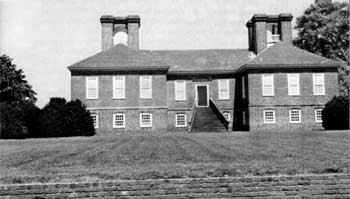







Survey of
Historic Sites and Buildings
 |
Stratford Hall Virginia |
 Stratford Hall |
| ||
This architecturally outstanding mansion along the Potomac River was the ancestral home of the Lee family. It was the birthplace and boyhood home of two signers of the Declaration of Independence, Richard Henry and Francis Lightfoot Lee, as well as their three distinguished brothers, Arthur, William, and Thomas Ludwell. A later resident was Col. Henry "Lighthorse Harry," hero of the War for Independence. His son, Robert E., Confederate leader during the Civil War, was born in the house in 1807.
Thomas Lee—planter, merchant, shipowner, and politician—built the mansion in the years 1725-30 on his 16,000-acre plantation. Upon his death in 1750, the residence passed to his eldest son, Philip Ludwell. Meantime, Richard Henry had been born there in 1732 and Francis Lightfoot 2 years later. They maintained residence until 1757 and 1758 respectively, when they moved to their own estates. In 1782 Philip Ludwell's oldest daughter, Matilda, wife of "Lighthorse Harry," her cousin, inherited the mansion. In 1790 she died, and 3 years later her husband remarried. One of his sons by that union was Robert E. Lee, who lived in the house only 3 or 4 years, at the end of which his parents moved to Alexandria.
Stratford Hall is a magnificent and rare example of an H-shaped residence and illustrates the transition from the 17th-century William and Mary style of architecture to early Georgian. The mansion is one story high over an elevated basement and has a hip roof. Variations in color and size between the Flemish bond brickwork in the basement and upper story soften the austerity of the bold mass of the house. In the central connecting arm, the flights of stone steps leading up to the north and south entrances, which diminish in width as they ascend to the main floor level and are flanked by ponderous balustrades, are conjectural reconstructions, erected in 1929. Twin sets of four huge chimney stacks are centered over the east and west wings. The stacks are connected by arches and encompass balustraded roof decks, from which the Lees could view navigation on the Potomac River.
"Lighthorse Harry" Lee made many changes. By 1800 he had altered or replaced the exterior stairs and changed most of the interior trim, except that in the central block's great hall, to the Adam style. The floor plan is unusual in colonial dwellings. The two wings each have four rooms, divided laterally by a central hallway on the main floor. The connecting central block consists of the fully paneled great hall, or salon—one of the most formal and monumental rooms of the early Georgian period in the English Colonies. The basement contains service rooms and some bedrooms; the main floor, living quarters and bedrooms. In the east wing's dining room is a service alcove, common in Virginia mansions. The 18th-century stairway was removed during the 1929 restoration. The only access between floors is now a small stairway in the east wing.
The mansion is built in the center of a square parterre, a service building being located at each corner of the square. Flanking the entrance forecourt are the kitchen and library, 1-1/2-story brick structures with jerkin-head roofs. At the rear corners are a school and office, with hip roofs. Outside the square are balanced brick buildings: a stable on one side and smokehouse on the other. Seven of the 12 original structures that were still standing in 1929 have been restored. They provide an excellent picture of plantation life in the 18th century. Farther removed from the house, near the wharf on the river, is the reconstructed mill.
In 1929 the Robert E. Lee Memorial Foundation, Inc., acquired the mansion and 1,100 acres. Besides reconstructing the exterior stairs, the foundation restored the library and library closet in the west wing, as well as the dining room and service alcove in the east wing, to their 18th-century appearance. The east and west corridors, parlor in the west wing, Robert E. Lee's birthplace room, and an adjoining bedroom in the east wing were left as they appeared about 1800. The formal garden, just east of the mansion, has also been restored. The foundation today operates Stratford Hall as a historic house museum.
 |
| Stratford Hall. (National Park Service, Littleton) |
 |
 |
http://www.cr.nps.gov/history/online_books/declaration/site54.htm
Last Updated: 04-Jul-2004